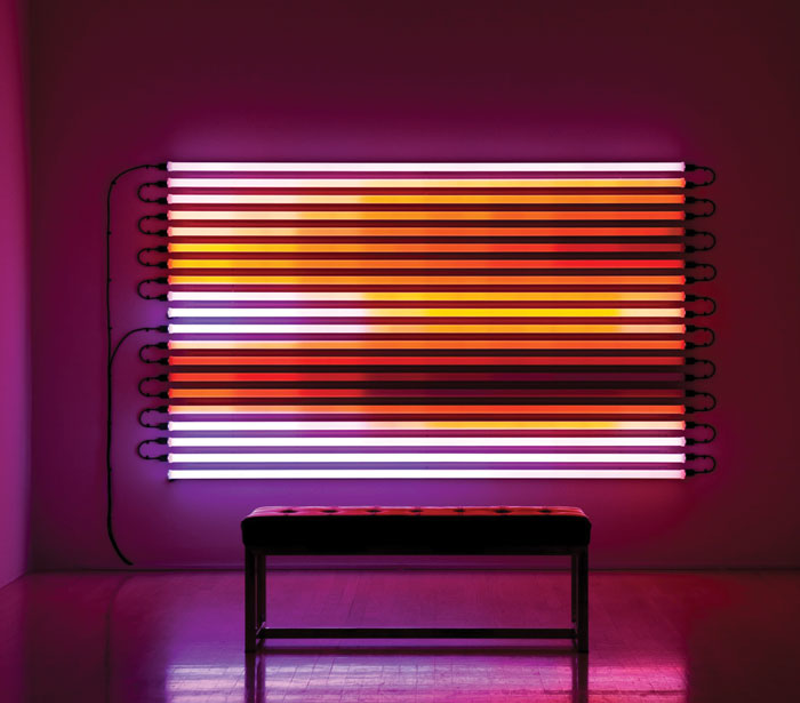Into the Ether, the current exhibit at the Dayton Art Institute (on view through June 26), gets its name from the fact that ether was once considered to be the substance in the universe that allowed light to travel and be seen.
But perhaps a better term for the show, one that explains what the six internationally recognized contemporary light artists displaying work are aiming for, is Into the Mystic.
As the most renowned of the group, James Turrell says in a brief video at the exhibit’s start that great artists of the past used paint to show light. He “just” replaces it with actual light, which has an intense emotional and spiritual dimension that can lead viewers to spend longer amounts of time experiencing its presence.
Also in this exhibit, which was co-curated by the DAI’s Aimee Marcereau DeGalan and Katherine Ryckman Siegwarth, are works by Robert Irwin, Leo Villareal, Erwin Redl, Daniel Rozin and Diane Willow. All are on loan, and the show is not set to travel.
Compared to Turrell’s celebrated “skyspace” rooms around the world as well as to his ongoing heroic project to convert the interior of an extinct Arizona volcano into an experiential art site, his two pieces here are understandably modest.
Yet like all his work, I find them amazing in his understanding of art and science. The pieces, from 2007 and 2008, use artificial light to demonstrate how color and shape can change based on our location and our concentration.
Like Turrell, Irwin came to prominence in the California Light and Space art movement of the 1970s, which used light and modern reflective materials to create holistic work that showed influences of Minimalism, Op Art and Color Field Painting. Irwin’s exhibited 2011 work “All That Jazz” tellingly uses light, shadow, reflection and color — all ephemeral materials — to create its effect.
What it “really” uses are fluorescent tubes wrapped with colored gels; the colors, layers of applied gel and brightness vary. On some, the color is pinstriped; on others it dominates. Even though the severe Minimalism in the roots of the piece is apparent, it has a subtle ambiance, an aura, that’s different and gentler. At times, the overall piece reminded me of the big keyboard that Tom Hanks walks on in Big.
Villareal’s 2004 “Chasing Rainbows” is a somewhat similar work, yet has a different effect. Long horizontal LED light tubes, arranged to look something like a flag’s proud stripes, change colors and patterns seemingly at random. Although there’s no clear pattern, it feels like a purposeful light show. It has a thrilling dynamism.
It’s fair to mention at this point that working with light is tricky. The piece’s physical parts can’t get in the way of the desired effect. A couple here failed that test for me. Willow’s 2014 “Chromosphere” seemed too much like a stage prop. And Rozin’s 2008 “Snow Mirror,” in which a camera picks up a viewer’s motions and translates them as snowflakes on a large silk screen, is only mildly diverting. (His “Brushed Metal Mirror” is much more effective.)
But Redl, an Austrian-born artist who has worked in Ohio, has two exceptional pieces, 2014’s “Twists and Turns” and 2006’s “Fade.” He’s an artist I like very much, and here, in a controlled environment, his work shines.
In an otherwise darkened room, his “Twists and Turns” installation uses animated blue and red lasers to send light bouncing off acrylic plates suspended from the ceiling. The reflections shine. You can make the plates move by trying windmill motions with your arms, or other actions. The piece not only works as art — it transforms the otherwise bland room — but also as exercise.
Overall, this kind of art isn’t radically new — Dan Flavin pioneered the use of light, itself, as subject and object (within fluorescent tubes) in the early 1960s.
But, according to the helpful guards at this show, it’s a relatively new experience for Dayton. One guard told me the curators wanted to try something different. Judging from the number of people attending on a Saturday afternoon and the time they spent with each piece, those curators are on to something.
Let there be light.
CONTACT STEVEN ROSEN: [email protected]


